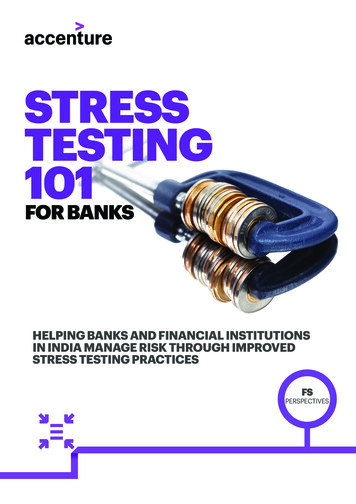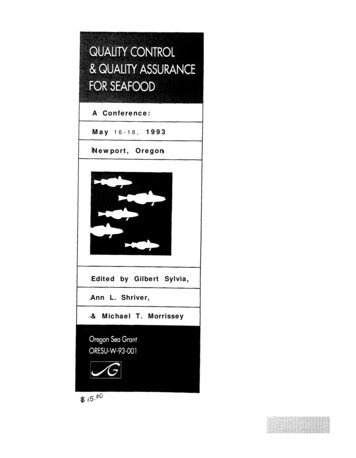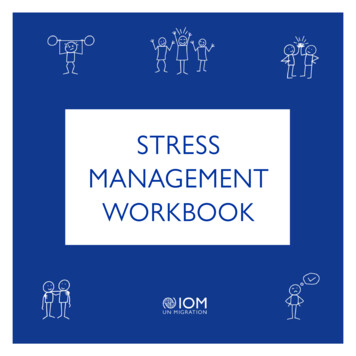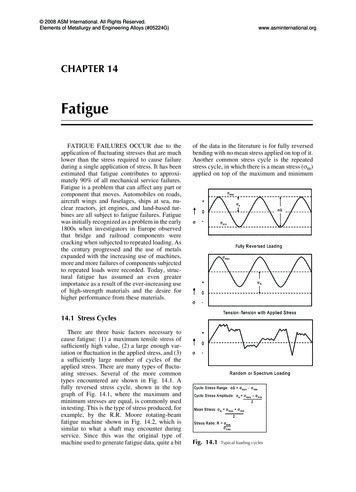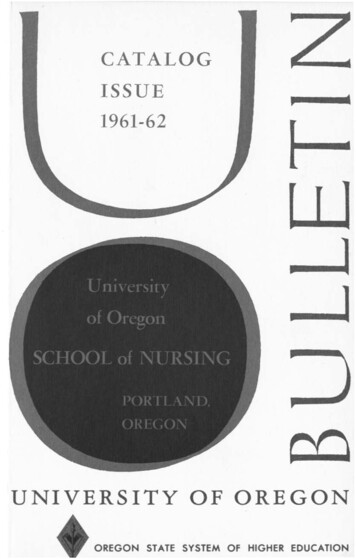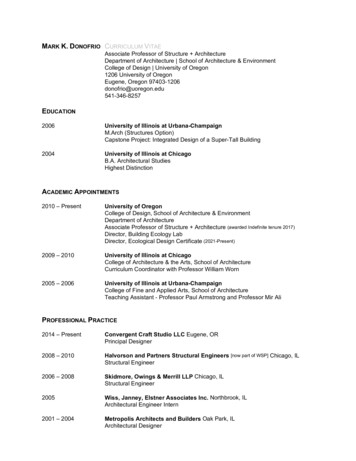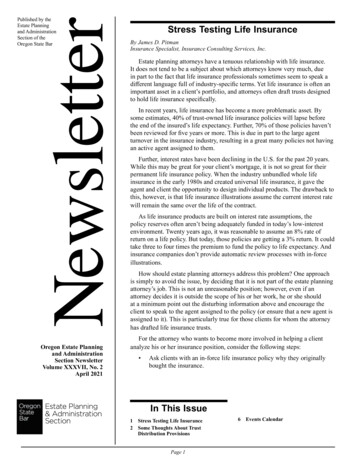
Transcription
Published by theEstate Planningand AdministrationSection of theOregon State BarStress Testing Life InsuranceBy James D. PitmanInsurance Specialist, Insurance Consulting Services, Inc.Estate planning attorneys have a tenuous relationship with life insurance.It does not tend to be a subject about which attorneys know very much, duein part to the fact that life insurance professionals sometimes seem to speak adifferent language full of industry-specific terms. Yet life insurance is often animportant asset in a client’s portfolio, and attorneys often draft trusts designedto hold life insurance specifically.In recent years, life insurance has become a more problematic asset. Bysome estimates, 40% of trust-owned life insurance policies will lapse beforethe end of the insured’s life expectancy. Further, 70% of those policies haven’tbeen reviewed for five years or more. This is due in part to the large agentturnover in the insurance industry, resulting in a great many policies not havingan active agent assigned to them.Further, interest rates have been declining in the U.S. for the past 20 years.While this may be great for your client’s mortgage, it is not so great for theirpermanent life insurance policy. When the industry unbundled whole lifeinsurance in the early 1980s and created universal life insurance, it gave theagent and client the opportunity to design individual products. The drawback tothis, however, is that life insurance illustrations assume the current interest ratewill remain the same over the life of the contract.As life insurance products are built on interest rate assumptions, thepolicy reserves often aren’t being adequately funded in today’s low-interestenvironment. Twenty years ago, it was reasonable to assume an 8% rate ofreturn on a life policy. But today, those policies are getting a 3% return. It couldtake three to four times the premium to fund the policy to life expectancy. Andinsurance companies don’t provide automatic review processes with in-forceillustrations.How should estate planning attorneys address this problem? One approachis simply to avoid the issue, by deciding that it is not part of the estate planningattorney’s job. This is not an unreasonable position; however, even if anattorney decides it is outside the scope of his or her work, he or she shouldat a minimum point out the disturbing information above and encourage theclient to speak to the agent assigned to the policy (or ensure that a new agent isassigned to it). This is particularly true for those clients for whom the attorneyhas drafted life insurance trusts.Oregon Estate Planningand AdministrationSection NewsletterVolume XXXVII, No. 2April 2021For the attorney who wants to become more involved in helping a clientanalyze his or her insurance position, consider the following steps: Ask clients with an in-force life insurance policy why they originallybought the insurance.In This Issue12Stress Testing Life InsuranceSome Thoughts About TrustDistribution ProvisionsPage 16Events Calendar
Estate Planning and Administration Section If it still aligns with their current needs, help theclient ensure that an active agent is assigned tothe policy. An active agent will help obtain theinformation described below. Have the client request an in-force ledger fromthe insurance company to determine if the policyis in good standing. He or she will get an idea ofwhat the performance projection looks like goingforward and how it will perform if the clientcontinues to pay what they’re currently paying. April 2021often devote only one paragraph out of a 20-, 30- or even50-page document to trust distribution language. And toooften, even that language is standardized: “all income,principal for standards.” This language has becomethe industry standard for so long that its usefulness orappropriateness is never questioned. But as any trustee cantell you, it can often lead to trouble between beneficiaries,or between a beneficiary and the trustee.If the policy is underperforming (that is, if it is notprojected to last for the client’s life expectancy),help the client determine how much they shouldincrease premiums in today’s lower interestenvironment. If paying more premium is not aviable option, consider reducing the death benefit tomatch their current premiums.Conduct a similar review process every three to fiveyears.Also, if the client needs to increase premium paymentsto adequately fund a policy, make sure the agent explainswhy, and shows what the numbers look like if the clientwants to keep the policy in effect through maturity.This article will attempt to redirect our thinking abouttrust distribution language. It will start by discussing thenature of such language, breaking it into either “objective”or “subjective” categories. It will discuss the pros andcons of each category, and present ways of thinkingdifferently about them. Next, it will provide some practicalalternatives to standard distribution language. Finally, itwill discuss the importance of “purpose” language.(Parenthetically, this article is also a sneak previewof a presentation that the author will give at the OregonState Bar Advanced Estate Planning continuing educationseminar in June. We are all about cross-selling here at thenewsletter!)I. Objective or Subjective Distributions?The universe of trust distribution provisions canbe divided into two large subsets: subjective andobjective provisions. Since the only provisions that mostbeneficiaries care about are those that deal with what theyget and when, reviewing the pros and cons of these twotypes with clients is very useful.One of the worst mistakes a client can make is holdingonto an inadequately funded policy for 10 or 20 years.By that point, the policy is vastly underfunded and hasdecades less compounded interest to build that shortfall.If you establish a review process with any new clients andan ongoing monitoring process with existing ones, you’llhelp ensure your client’s policies are adequately fundedthroughout their lifetime. It is a great way to demonstrateyour breadth of knowledge to a client beyond the estateplanning law.Objective TermsThere are generally two groups of objective trust terms:income-based and incentive-based. The income-basedterms are the traditional group most estate planners arefamiliar with; under this model a beneficiary is entitledto all the income from the trust. There are a couple ofmodern offshoots, the unitrust and the adjustment betweenprincipal and income. Both, however, are based on thetraditional notion of “all income,” but with modificationsto take into account the mandates of modern portfoliotheory.Some Thoughts About TrustDistribution ProvisionsBy Christopher P. ClineRiverview Trust CompanyThe second group, incentive trusts, gained popularityover 20 years ago. Indeed, a 1999 article in the Wall StreetJournal discussed their use.1 The article actually mentionedseveral incentive trust provisions, which are illustrativeof the type of provisions common to the trust: matchingearned income up to a specified amount; distributing afixed amount for the beneficiary to start a business orDrafters of trusts have so much to think about: trustprotectors, trustee succession, governing law, tax clauses,estate and gift tax issues, protection from creditors. It isan incredibly complex and difficult task, and many of ushave spent long careers trying to perfect that craft. It isstrange, then, that the most controversial area of draftingsometimes seems to get the least amount of attention.Beneficiaries only care about two things: how muchdo I get and when do I get it? All of the other draftingissues mentioned above matter only to the extent that theyaffect the answers to those two questions. Yet trust drafters1 Cited in Stephens, Incentive Trusts: Considerations, Usesand Alternatives, 29 ACTEC Journal 5 (Summer 2003)(hereinafter “Stephens”). See also McCue, Planning andDrafting to Influence Behavior, 34 U. of Miami, Phillip E.Heckerling Inst. of Est. Plan. (2000) (hereinafter “McCue”).Page 2
Estate Planning and Administration SectionApril 2021professional practice; making a monthly payment fora “stay-at-home” parent; denying distributions if thebeneficiary fails a drug or alcohol test; and making fixeddistributions for each year in which a beneficiary has nodriving violations.2example, may find herself impoverished if the trust is notdrafted broadly enough. In a more general sense, anyonewho drafts a long-term trust with specific, objective terms,believing he knows what the world will look like 20 or 50years from now, is probably thinking too narrowly.Such provisions have some superficial appeal and (atleast in the case of drug testing) may be critical in caringfor a beneficiary. They encourage or discourage positiveor negative beneficiary behaviors. They are also easy toadminister: show me your W-2 and I will give you themoney, pass your drug test and I will give you the money.They leave no room for a trustee to be over-indulgent.Finally, and most importantly, a grantor who creates anincentive trust that focuses on behaviors usually doesn’tseek to promote those behaviors per se. Instead, the grantorseeks to promote something that the behaviors represent.For example, a client is not really trying to encourageW-2 income, but rather productivity; entrepreneurship isultimately less important than “independence, ingenuityand innovation.”3 In other words, the grantor identifiescertain behaviors that are a surrogate for maturity anddrive. But by naming surrogates rather than the thing itself,the grantor runs the very serious risk of missing the markaltogether: a “teacher of the year” might receive smallertrust distributions than a mediocre lawyer.However, objective provisions also have seriousproblems. The traditional “income only” provisions arevirtually useless in most settings, because they bear norelation to any goals that the grantor might have. Theincome might be too much or too little for purposes forwhich the trust was created. The same is true for unitrustsand for income with the trustee’s ability to adjust betweenprincipal and income: neither relates to real-world clientgoals for the beneficiary. They are often as not short-handsolutions suggested by the drafter.One variant of the “income-only” model has somerelevance to real world goals, and that is the dollar amount,adjusted for inflation. For instance, the beneficiary is toreceive 100,000 per year, adjusted for inflation. This typeof provision allows the grantor to establish a standardof living by creating essentially a salary from the trust.Inflation adjustment is obviously critical in this context toensure that the beneficiary does not lose pace to inflationover time. Note that, even in those cases when an “allincome” provision is required (for example, in the case ofQTIP trusts), a “greater of” provision can be used (i.e., thebeneficiary shall be entitled to the greater of all net incomeor the inflation adjusted dollar amount).Another problem with objective provisions is that theycannot adapt to the needs of a particular individual. Forexample, by promoting a daughter to stay at home with herchildren, they might discourage her developing her naturalabilities in other areas. Further, by simply encouraginghigher earnings, the trust terms might convince abeneficiary who wanted to be a schoolteacher to be alawyer instead. To take this notion further, a document thatspecifically provides for one thing specifically excludesanother. Behaviors not specifically set forth, but whichmay be equally desirable, are not accounted for.A third problem is that objective provisions, whichare fundamentally restrictive, do not allow for changingcircumstances. The beneficiary who develops a debilitatingillness that prevents her from earning at prior levels, for2Id.Subjective TermsIf objective provisions are inadequate, does that meanthat we should favor subjective instead? Subjectiveprovisions are those that require the exercise of discretionby the trustee in making certain value judgments. Forexample, the subjective standard most of us are familiarwith is the trustee’s ability to distribute principal for“health, education, maintenance and support.” The trusteemust decide what constitutes “support,” which couldinclude living in anything from a shack to a mansion. Thisflexibility is seen by many as a significant benefit. At leastone commentator has noted that objective, “incentive”provisions are not the solution to most family relationshipproblems, and so should not be the “first weapon outof the arsenal.”4 Indeed, the incentive trust works best“in the most desperate situations” (as an alternative todisinheritance for a beneficiary engaging in anti-socialbehavior, for instance).5 Discretionary trusts “should beseen as generally preferable to incentive trusts” because ofthe increased flexibility.6However, if a discretionary trust is to be used, severaladditional provisions should be added. First, the grantorshould give clear guidance as to the exercise of thediscretion. The grantor’s intention “should be set forth insufficient detail to tell the trustee what the [grantor] reallywants.”7 Further, trustee exculpation should be added,including perhaps provisions that set forth how the costsof litigation are to be paid (such costs may be assessedagainst the beneficiary who brought it, for example).3 Id.4 McCue, supra note 1, at § 609.2.5 Id.6 Id. at § 609.3.7 Id.Page 3
Estate Planning and Administration SectionApril 2021Add “Standards” Preferences to All Trusts.A great many, probably most, irrevocable trusts allowfor distributions of principal for a beneficiary’s “health,education, maintenance and support.” However, not all ofthese standards necessarily are created equal. Is educationmore important than other purposes, for example?Clarity about standards is not often included, but manygrantors do have strong feelings about priority. This tip isespecially useful with the inflation adjusted dollar amount.In that case, education and medical care would likely beemphasized over support or maintenance.These measures will ensure that the trustee will exercisediscretion in a manner as close as possible to that thegrantor intended, with less fear that he or she will be suedfor doing so.Finally, even if such provisions are added, someproblems remain. First, the more discretion given tothe trustee, the greater the likelihood that the trusteewill exercise it in a manner the grantor would not haveagreed with. This may not be all bad, by the way. Second,discretion guarantees only flexibility, not success.II. Ways of Thinking About Drafting.Don’t Use “All Income.”There are few habits in trust drafting as thoughtless andcounterproductive as giving a beneficiary “all income.”Excluding the few times when it is required (in QTIPtrusts, for example), there is no reason to give a beneficiaryall income. It has no relation to any real world goal, andpits beneficiaries against each other, because the trustee’sinvestment choices benefit one beneficiary over another.Honestly, “all income” just makes no sense. The onlysolid argument in favor of an “all income” standard is thatit’s better to pass income out to the beneficiaries so thatthey can pay at their (often) lower income tax rates thanto retain the income in the trust and pay income tax at thecompressed (and typically higher) trust rates. But suchan approach means giving the beneficiary a potentiallylarger distribution than is appropriate, simply to reduce theoverall amount of tax paid. This could be argued as beingsimply a case of “the tax tail wagging the dog” (althoughthere is room for argument on both sides).But if “all income” doesn’t make sense, what does?Consider an Inflation-Adjusted Dollar Amount.If “all income” is the most overused distributionprovision, the most underused is the inflation-adjusteddollar amount (e.g., “beneficiary shall receive 75,000per year, increased in each year by CPI”). No clientknows how much “all income” will buy in the future, buteveryone knows how much 75,000 per year in today’sdollars will buy. Using this standard makes principaldistributions easier to draft as well, because there will beless need for “support” or “maintenance” if a minimumstandard has been applied.Be More Specific About What the Standards Mean.For too long we’ve blindly referred to “health,education, maintenance and support,” for no good reasonother than they’re included in the Internal Revenue Code.Consider the following:First, why do we even use “maintenance” and “support”when the Regulations state clearly that they are identicalterms? This is not a substantive issue, but rather evidencethat we’ve tended to gloss over the issue.Second, paying for a beneficiary’s support can oftenbe contrary to not only the grantor’s objectives (mostgrantors want their beneficiaries to be productive) butalso the factors that tend to create long-term beneficiaryhappiness (there is much evidence to support the idea thatself-sufficiency is more important to overall happiness thanmore money). Of course, there are plenty of circumstancesin which support is appropriate (when a beneficiary isattending college, for instance, or for a surviving spousewho has spent her life working in the home). But thenumber of times that the term is actually used probablyoutweighs the number of times it’s appropriately used.Third, broaden “education” to include things likepersonal enrichment classes and courses that lead toprofessional designations. Such courses may help withthe beneficiary’s personal growth and are unlikely to sap abeneficiary’s incentive.Consider a Unitrust.If the inflation-adjusted dollar amount is too radical foryou, at least consider the unitrust distribution. This has twobenefits over “all income”: the trustee can invest for totalreturn, and not income production, and the percentage canbe fine-tuned more than “income” can.Fourth, distributions for “health” should almost alwaysbe added, and might be expanded to be clear that thetrustee can pay insurance premiums and perhaps alsoreimburse employee co-pays for such insurance. Whilewe’re on the subject of insurance, by the way, “health”might also include payment of insurance premiums fordisability, AD&D and perhaps even long-term care or lifeinsurance designed to replace the income of the workingspouse in the event of her death (being mindful, of course,not to create any “incidents of ownership” problems).Realize That “May Look to Other Resources” ReallyMeans “Shall” Look to Them.Many trust agreements state that the trustee “may”consider other resources when considering whether toPage 4
Estate Planning and Administration SectionApril 2021make discretionary principal distributions to a beneficiary.However, when considering the trustee’s undivided dutyof loyalty to both current and remainder beneficiaries, astrong argument can be made that a trustee with the abilityto consider other resources should always do so. For thisreason, most if not all corporate trustees consider “may” inthis context to mean “shall.”This is not merely a corporate trustee issue, however.Attorneys advising individual trustees should probablycounsel those trustees to take the same position. A trusteewho has the ability to take into account other resourcesbut does not do so opens herself up to potential liabilityexposure to the remainder beneficiaries for spending toomuch trust money needlessly. On the other hand, it seemsunlikely that a current beneficiary would have groundsto pursue the trustee for not making distributions to thatbeneficiary when she already had sufficient resources ofher own.III. Purpose.One final factor that doesn’t directly address thesize of distributions but that can have a huge impacton the trustee’s and beneficiary’s perspectives towarddistributions is “purpose” language. Purpose in a documentgives the beneficiaries and trustee knowledge about whythe trust exists. Failure to define purpose is one of thebiggest drafting flaws because it allows the beneficiary tosay, “but Mom always wanted me to have ” (fill inthe blank with bigger distributions). In fact, most plannerswould acknowledge that this is so.However, even though we might recognize itsimportance, most drafters still don’t seem to use “purpose”language. This has been a historical problem. Over 50years ago, the Oregon Supreme Court noted that“[t]he difficulty in many if not most of these[abuse of trustee discretion] cases is finding thepurpose of the settlor with sufficient definitenessto be helpful . . . . The settlor’s specific designin framing a discretionary trust is normallyunexpressed or vaguely outlined.”8Two years later, Professor Edward C. Halbach, Jr.,repeated those sentiments:“[t]oo frequently trust instruments provide noguidance as to the purpose and scope of the[discretionary] power. Although determiningand assisting in the formulation of the donor’sintentions is a primary counseling function, it isapparently one of the most neglected aspects of8Rowe v. Rowe, 219 Or. 599, 606; 347 P.2d 968, 972 (1959).estate planning. A poorly defined discretionarypower often results.”9The challenge with purpose language, of course, is thatit risks becoming too “touchy-feely”; that is, the languageis either too vague or too particular to resolve distributionquestions.Nevertheless, regardless of the purpose for which itis intended, any trust can benefit from a clear statementof the grantor’s intent. This is the area of drafting mostoverlooked by lawyers, and also potentially the mostcritical to the success of a trust administration. Suchlanguage should be included in a separate paragraph,so that there is no risk of a trustee or a court confusingprecatory purpose language with distribution language.One further “purpose” provision that would generallybe useful is a statement of beneficiary preference. That is, aseparate paragraph that states which beneficiary’s interestsare to be considered more important than another’s. Forexample, is this a trust primarily for the benefit of thecurrent or remainder beneficiaries? Should one class befavored over another? Take the case of a trust for thebenefit of a second spouse during that spouse’s lifetime,with the remainder passing to two children from a priormarriage. If the spouse does not have significant assets inher own name, the trust might state that her interests aresuperior to those of the children. On the other hand, if thespouse has significant assets of her own, the trust mightbe considered a “backstop” only, to be used if the spouse’sassets run out. In this case, the beneficiaries with the moreimportant rights are the children.Although this is sometimes very hard for a grantor todeal with, if such expressions of preference were usedmore frequently, many trust disputes would be resolvedmore quickly (to the extent that they are ever resolved atall).*****Trust drafting is always challenging because the lawseems to always be changing under our feet. But thebiggest challenge in trust administration, determining howmuch and when to distribute to beneficiaries, is constantand unchanging. Hopefully, this brief article can helptrust drafters to make this challenge a little easier for theirtrustees.9Page 5Halbach, Problems of Discretion in Discretionary Trusts, 61Colum. L. Rev. 1424, 1434 (1961).
Estate Planning and Administration SectionApril 2021Oregon Estate Planning and AdministrationSection NewsletterEditorial BoardLisa AllenPhilip N. JonesSusan B. BockTimothy R. StraderJanice HattonVanessa UsuiMelissa LandeQuestions, Comments, SuggestionsAbout This Newsletter?Contact: Chris Cline, Editor-in-Chief(360) 759-2478, chriscline@riverviewbank.comDisclaimerThe articles and notes in the Oregon StateBar Estate Planning and Administration SectionNewsletter may contain analysis and opinions thatdo not necessarily reflect the analysis and opinionsof the Newsletter Editor-in-Chief, the EditorialBoard, the Estate Planning Section Board or themembership of the Estate Planning Section. It is theresponsibility of each practitioner to perform theirown research and analysis and to reach their ownopinions.Events CalendarThe Editors want to include announcements of upcomingevents that are open to the public and may be of interestto our readers. If you know of an event, please sendbasic information, including point of contact informationto Chris Cline at chriscline@riverviewbank.com forinclusion in the next issue of the Newsletter.Advanced Estate Planning and AdministrationVirtual CLE ProgramFriday, June 4, 202Co-sponsored by the Oregon State Bar and theEstate Planning and Administration SectionPage 6
When the industry unbundled whole life insurance in the early 1980s and created universal life insurance, it gave the agent and client the opportunity to design individual products. The drawback to this, however, is that life insurance illustrations assume the current interest rate will remain the same over the life of the contract.
